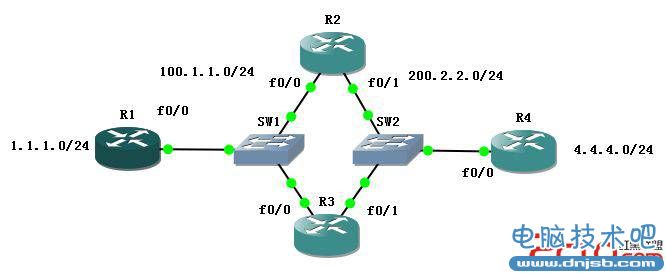- 冒险村物语
- 英雄无敌3塔防
- 驾考家园手游
ccnp第1讲之笔记(静态路由)
2015-06-17
ccnp第1讲之笔记(静态路由)
一、路由条目的选择:对于目的地和掩码相同的路由条目,先比较管理距离(代表路由条目的来源),管理距离小的存放如路由表中;管理距离一样的比较度量值(metric),度量值表示路径的好坏,选择小的加表,如果一样则同时加表,这点就实现了基于三层的负载均衡。
www.zhishiwu.com
www.zhishiwu.com
二、静态路由的配置:ip route 目的ip 掩码 X(下一跳地址或者出站接口) [distance] [permanent]
X什么时候写下一跳地址,什么时候写出站接口?
网段大体分为2类:多路访问(MA),点到点(P2P); 其中MA包括以太网,帧中继,P2P包括HDLC,PPP。
如果静态路由对应的出口接口是一个MA接口,建议选择下一跳地址,因为MA网段可能包含多个节点,如果不是选择下一跳而是出站接口,会导致转发路由器无限地针对目的ip进行arp请求,并且如果对端路由器开启了代理arp,不管请求谁的mac地址,都会回复自己的mac地址。这会导致大量的arp在网络中转发,浪费了带宽和arp表项。如果是P2P网段,建议选择出站接口,因为如果选择下一跳,路由器会对下一跳地址进行路由查询来找到出口接口,这样就造成了递归表查询。所以,建议全写,既写下一跳地址,又写出站接口。
www.zhishiwu.com
www.zhishiwu.com
三、用静态路由做路由控制
对于距离矢量路由协议:在路由协议A中将一个接口使用NETWORK语句宣告进协议A,会实现该接口对于该协议报文的收发
收:邻居传递过来的所有路由条目
发:该路由器所有被宣告进协议A的接口的C(直连)路由,以及通过这下接口获悉的邻居传递过来的属于该协议的并且被加入路由表的路由。
在DV(距离矢量)协议中,使用静态路由就可以覆盖通过DV IGP获悉的动态路由条目,实现该路由条目的传递过滤,在LS(链路状态) IGP中,静态路由无法实现路由过滤。
四、静态路由命令参数
A、permanent(永久存在)
在没有加permanent参数时,如果静态路由所关联的发包接口shutdown了,则这条路由条目也不会存在。
在SVC(交换虚电路,按照需求才产生链路,没有链路时接口就是shutdown的)中,使用静态路由就常常使用到这个参数。
B、distance
使用静态路由使用冗余备份,即浮动静态路由
在运行路由协议X的网络中,添加一条大于该协议X的管理距离的静态路由,当协议X产生的路由链路出现故障时,则这条静态路由会作为备用路由出现,否者不会出现在路由表中。
只在拥有冗余链路的时候才建议使用这个参数做备份,其他时候不建议使用。
五、
对于PC,如果该设备接收到了路由器传递的代理arp reply,则该PC会无条件的信任这个reply,并且将其加入arp表中。
对于路由器,如果该设备接收到了代理arp reply ,则该路由器会优先判断该reply中应答者IP地址所在的网段是否可达,如果是,则接受,如果不是,则直接丢弃。
六、
递归路由、代理arp的实验
实验目的:当静态路由的下一跳为非直连ip时,研究递归路由的情况;研究arp的情况。
实验拓扑:

实验步骤:
1、配置完基本命令及ip
2、在R1上做静态路由,下一跳为R4的F0/0:ip route 4.4.4.0 255.255.255.0 f0/0 200.2.2.4
R2和R3:ip route 4.4.4.0 255.255.255.0 f0/1 200.2.2.4
3、R2,R2,R3都debug arp。
4、在R1:ping 4.4.4.4
观察结果:R1:
*Mar 1 01:07:56.203: IP ARP: creating incomplete entry for IP address: 200.2.2.4 interface FastEthernet0/0
*Mar 1 01:07:56.203: IP ARP: sent req src 100.1.1.1 c800.04c4.0000,
dst 200.2.2.4 0000.0000.0000 FastEthernet0/0
*Mar 1 01:07:56.255: IP ARP rep filtered src 200.2.2.4 c802.04c4.0000, dst 100.1.1.1 c800.04c4.0000 wrong cable, interface FastEthernet0/0
*Mar 1 01:07:56.255: IP ARP rep filtered src 200.2.2.4 c801.04c4.0000, dst 100.1.1.1 c800.04c4.0000 wrong cable, interface FastEthernet0/0.
*Mar 1 01:07:58.199: IP ARP throttled out the ARP Request for 200.2.2.4.
*Mar 1 01:07:56.203: IP ARP: sent req src 100.1.1.1 c800.04c4.0000,
dst 200.2.2.4 0000.0000.0000 FastEthernet0/0
*Mar 1 01:07:56.255: IP ARP rep filtered src 200.2.2.4 c802.04c4.0000, dst 100.1.1.1 c800.04c4.0000 wrong cable, interface FastEthernet0/0
*Mar 1 01:07:56.255: IP ARP rep filtered src 200.2.2.4 c801.04c4.0000, dst 100.1.1.1 c800.04c4.0000 wrong cable, interface FastEthernet0/0.
*Mar 1 01:07:58.199: IP ARP throttled out the ARP Request for 200.2.2.4.
R2:
*Mar 1 01:07:26.531: IP ARP: rcvd req src 100.1.1.1 c800.04c4.0000, dst 200.2.2.4 FastEthernet0/0
*Mar 1 01:07:26.531: IP ARP: sent rep src 200.2.2.4 c801.04c4.0000,
dst 100.1.1.1 c800.04c4.0000 FastEthernet0/0
*Mar 1 01:07:26.531: IP ARP: sent rep src 200.2.2.4 c801.04c4.0000,
dst 100.1.1.1 c800.04c4.0000 FastEthernet0/0
R3:
*Mar 1 01:06:55.627: IP ARP: rcvd req src 100.1.1.1 c800.04c4.0000, dst 200.2.2.4 FastEthernet0/0
*Mar 1 01:06:55.631: IP ARP: sent rep src 200.2.2.4 c802.04c4.0000,
dst 100.1.1.1 c800.04c4.0000 FastEthernet0/0
*Mar 1 01:06:55.631: IP ARP: sent rep src 200.2.2.4 c802.04c4.0000,
dst 100.1.1.1 c800.04c4.0000 FastEthernet0/0
R1查找路由,知道到4.4.4.4的下一跳为200.2.2.4,但是不知道200.2.2.4怎么去,于是发送arp请求,通过f0/0端口广 播出去,而R2、R3知道到200.2.2.4怎么去,同时代理arp是默认开启的,于是都回复arp reply,告诉R1 200.2.2.4的mac地址是自己的F0/0 mac地址。
于是R1收到的arp reply是这样的:200.2.2.4的mac地址是xxx-xxx-xxx(R2或者R3的相应端口mac)。同时R1又发现200.2.2.4不可达,于是丢弃。通过show arp验证是否丢弃:
r1#show arp
Protocol Address Age (min) Hardware Addr Type Interface
Internet 100.1.1.1 - c800.04c4.0000 ARPA FastEthernet0/0
Internet 100.1.1.2 71 c801.04c4.0000 ARPA FastEthernet0/0
Internet 100.1.1.3 71 c802.04c4.0000 ARPA FastEthernet0/0
r1#
Protocol Address Age (min) Hardware Addr Type Interface
Internet 100.1.1.1 - c800.04c4.0000 ARPA FastEthernet0/0
Internet 100.1.1.2 71 c801.04c4.0000 ARPA FastEthernet0/0
Internet 100.1.1.3 71 c802.04c4.0000 ARPA FastEthernet0/0
r1#
可以发现,arp表中并没有200.2.2.4的项目。
5、从上面可以看到只要再给R1一个静态路由,告诉它200.2.2.4可达,是否就可以添加上200.2.2.4的arp项?好的,现在来做一下:
R1:
ip route 200.2.2.0 255.255.255.0 f0/0 100.1.1.2
ping 4.4.4.4
查看结果:
Sending 5, 100-byte ICMP Echos to 4.4.4.4, timeout is 2 seconds:
*Mar 1 01:30:32.247: IP ARP: creating incomplete entry for IP address: 200.2.2.4 interface FastEthernet0/0
*Mar 1 01:30:32.247: IP ARP: sent req src 100.1.1.1 c800.04c4.0000,
dst 200.2.2.4 0000.0000.0000 FastEthernet0/0
*Mar 1 01:30:32.299: IP ARP: rcvd rep src 200.2.2.4 c802.04c4.0000, dst 100.1.1.1 FastEthernet0/0
*Mar 1 01:30:32.303: IP ARP: rcvd rep src 200.2.2.4 c801.04c4.0000, dst 100.1.1.1 FastEthernet0/0…..
Success rate is 0 percent (0/5)
*Mar 1 01:30:32.247: IP ARP: sent req src 100.1.1.1 c800.04c4.0000,
dst 200.2.2.4 0000.0000.0000 FastEthernet0/0
*Mar 1 01:30:32.299: IP ARP: rcvd rep src 200.2.2.4 c802.04c4.0000, dst 100.1.1.1 FastEthernet0/0
*Mar 1 01:30:32.303: IP ARP: rcvd rep src 200.2.2.4 c801.04c4.0000, dst 100.1.1.1 FastEthernet0/0…..
Success rate is 0 percent (0/5)
查看arp表show arp:
Protocol Address Age (min) Hardware Addr Type Interface
Internet 100.1.1.1 - c800.04c4.0000 ARPA FastEthernet0/0
Internet 100.1.1.2 83 c801.04c4.0000 ARPA FastEthernet0/0
Internet 100.1.1.3 83 c802.04c4.0000 ARPA FastEthernet0/0
Internet 200.2.2.4 3 c801.04c4.0000 ARPA FastEthernet0/0
Internet 100.1.1.1 - c800.04c4.0000 ARPA FastEthernet0/0
Internet 100.1.1.2 83 c801.04c4.0000 ARPA FastEthernet0/0
Internet 100.1.1.3 83 c802.04c4.0000 ARPA FastEthernet0/0
Internet 200.2.2.4 3 c801.04c4.0000 ARPA FastEthernet0/0
发现arp请求只发送了一次,并且在arp表里已经有了200.2.2.4的表项,上面显示为R2的f0/0 mac地址,如果在R4中有回包路由,就可以ping通了。所走的路径就是R1-R2-R4。
那么,在R1中,这条静态路由(称为A, S 200.2.2.0/24 [1/0] via 100.1.1.2, FastEthernet0/0)的作用是什么?
A路由是为了主路由(称为B, S 4.4.4.0 [1/0] via 200.2.2.4, FastEthernet0/0)而服务的,所以可以称A路由为递归路由,那么递归路由在寻径过程中的作用是什么?影不影响路径的选择?
仔细观察下递归路由S 200.2.2.0/24 [1/0] via 100.1.1.2, FastEthernet0/0,其中也有下一跳via 100.1.1.2,那么这个下一跳地址对于寻径有没有影响呢?是不是这样的:当这个下一跳为R2的F0/0时,就走上面的路径(R1-R2-R4);而 当下一跳为R3的F0/0时,就走下面的路径(R1-R3-R4)?
下面我就来验证下能不能,先shutdown掉R2,然后重新写一个下一跳走R3的递归路由,看看结果。好的,我先让R1能够ping通:
6、在R4上做一个回包路由:ip route 100.1.1.0 255.255.255.0 f0/0 200.2.2.2
并且做个负载均衡
ip route 100.1.1.0 255.255.255.0 f0/0 200.2.2.3
查看结果R4:show ip route
100.0.0.0/24 is subnetted, 1 subnets
S 100.1.1.0 [1/0] via 200.2.2.2, FastEthernet0/0
[1/0] via 200.2.2.3, FastEthernet0/0
4.0.0.0/24 is subnetted, 1 subnets
C 4.4.4.0 is directly connected, Loopback0
C 200.2.2.0/24 is directly connected, FastEthernet0/0
S 100.1.1.0 [1/0] via 200.2.2.2, FastEthernet0/0
[1/0] via 200.2.2.3, FastEthernet0/0
4.0.0.0/24 is subnetted, 1 subnets
C 4.4.4.0 is directly connected, Loopback0
C 200.2.2.0/24 is directly connected, FastEthernet0/0
R1:
r1#ping 4.4.4.4
Type escape sequence to abort.
Sending 5, 100-byte ICMP Echos to 4.4.4.4, timeout is 2 seconds:
!!!!!
Success rate is 100 percent (5/5), round-trip min/avg/max = 24/50/96 ms
Sending 5, 100-byte ICMP Echos to 4.4.4.4, timeout is 2 seconds:
!!!!!
Success rate is 100 percent (5/5), round-trip min/avg/max = 24/50/96 ms
7、shutdown掉R2,重新做个走R3的递归路由
r2(config-if)#int f0
*Mar 1 02:17:39.147: %LINK-5-CHANGED: Interface FastEthernet0/0, changed state to administratively down
*Mar 1 02:17:40.147: %LINEPROTO-5-UPDOWN: Line protocol on Interface FastEthernet0/0, changed state to down
r2(config-if)#int f0/1
r2(config-if)#shutd
r2(config-if)#
*Mar 1 02:17:47.027: %LINK-5-CHANGED: Interface FastEthernet0/1, changed state to administratively down
*Mar 1 02:17:48.027: %LINEPROTO-5-UPDOWN: Line protocol on Interface FastEthernet0/1, changed state to down
*Mar 1 02:17:39.147: %LINK-5-CHANGED: Interface FastEthernet0/0, changed state to administratively down
*Mar 1 02:17:40.147: %LINEPROTO-5-UPDOWN: Line protocol on Interface FastEthernet0/0, changed state to down
r2(config-if)#int f0/1
r2(config-if)#shutd
r2(config-if)#
*Mar 1 02:17:47.027: %LINK-5-CHANGED: Interface FastEthernet0/1, changed state to administratively down
*Mar 1 02:17:48.027: %LINEPROTO-5-UPDOWN: Line protocol on Interface FastEthernet0/1, changed state to down
R1:
r1(config)#no ip route 200.2.2.0 255.255.255.0 f0/0 100.1.1.2
r1(config)#ip route 200.2.2.0 255.255.255.0 f0/0 100.1.1.3
8、在R1、R4上打开debug,然后查看结果
r1#debug ip packet detail
IP packet debugging is on (detailed)
r1#debug ip icmp
ICMP packet debugging is on
IP packet debugging is on (detailed)
r1#debug ip icmp
ICMP packet debugging is on
r4#debug ip packet detail
IP packet debugging is on (detailed)
r4#debug ip icmp
ICMP packet debugging is on
IP packet debugging is on (detailed)
r4#debug ip icmp
ICMP packet debugging is on
查看结果R1:
r1#ping 4.4.4.4
Type escape sequence to abort.
Sending 5, 100-byte ICMP Echos to 4.4.4.4, timeout is 2 seconds:
Sending 5, 100-byte ICMP Echos to 4.4.4.4, timeout is 2 seconds:
*Mar 1 02:30:29.515: IP: s=100.1.1.1 (local), d=4.4.4.4 (FastEthernet0/0), len 100, sending
*Mar 1 02:30:29.515: ICMP type=8, code=0.
*Mar 1 02:30:31.515: IP: s=100.1.1.1 (local), d=4.4.4.4 (FastEthernet0/0), len 100, sending
*Mar 1 02:30:31.515: ICMP type=8, code=0.
*Mar 1 02:30:33.515: IP: s=100.1.1.1 (local), d=4.4.4.4 (FastEthernet0/0), len 100, sending
*Mar 1 02:30:33.515: ICMP type=8, code=0.
*Mar 1 02:30:35.515: IP: s=100.1.1.1 (local), d=4.4.4.4 (FastEthernet0/0), len 100, sending
*Mar 1 02:30:35.515: ICMP type=8, code=0.
*Mar 1 02:30:37.515: IP: s=100.1.1.1 (local), d=4.4.4.4 (FastEthernet0/0), len 100, sending
*Mar 1 02:30:37.515: ICMP type=8, code=0.
Success rate is 0 percent (0/5)
*Mar 1 02:30:29.515: ICMP type=8, code=0.
*Mar 1 02:30:31.515: IP: s=100.1.1.1 (local), d=4.4.4.4 (FastEthernet0/0), len 100, sending
*Mar 1 02:30:31.515: ICMP type=8, code=0.
*Mar 1 02:30:33.515: IP: s=100.1.1.1 (local), d=4.4.4.4 (FastEthernet0/0), len 100, sending
*Mar 1 02:30:33.515: ICMP type=8, code=0.
*Mar 1 02:30:35.515: IP: s=100.1.1.1 (local), d=4.4.4.4 (FastEthernet0/0), len 100, sending
*Mar 1 02:30:35.515: ICMP type=8, code=0.
*Mar 1 02:30:37.515: IP: s=100.1.1.1 (local), d=4.4.4.4 (FastEthernet0/0), len 100, sending
*Mar 1 02:30:37.515: ICMP type=8, code=0.
Success rate is 0 percent (0/5)
而这个时候R4上没有收到任何数据包
r4#debug ip packet detail
IP packet debugging is on (detailed)
r4#debug ip icmp
ICMP packet debugging is on
r4#
r4#
IP packet debugging is on (detailed)
r4#debug ip icmp
ICMP packet debugging is on
r4#
r4#
这代表R2 DOWN掉的时候,仍然走的是上面的路径,并没有走下面的路径。
所以递归路由的作用仅仅是在R1收到ARP Reply时,告诉R1这个reply是可信赖的,即目标网段是可达的。无论下一跳地址是什么,都不影响路径的选择,而影响路径选择的是R1的arp表中目标地址的mac,这个mac地址是由R2、R3的 arp reply决定的,即R2、R3的arp reply谁后到,谁就是arp表项中的地址。
但是递归路由的作用是为了增加静态路由的灵活性。
那么怎么样才能实现这个灵活性呢?即当R2 DOWN的时候走下面的路径,R3 DOWN的时候走上面的路径?
这个时候要先了解一下arp发送的根本原理:在路由器中,对于一个目的ip地址,如果arp中有这个IP的表项,那么除非这个表项消失,否者路由器永远不会对这个IP地址进行arp请求。而arp表项的存在时间默认是4个小时。
所以,只要修改了arp表项的存在时间,就可以很快速的实现路由切换。
好的,我来做一下:
9、修改R1的arp表项 存在时间为10秒,同时也要修改R4的为10秒
r1(config)#int f0/0
r1(config-if)#arp timeout ?
<0-2147483> Seconds
r1(config-if)#arp timeout ?
<0-2147483> Seconds
r1(config-if)#arp timeout 10
这个时候,R1马上就产生了一个提示信息
*Mar 1 02:48:01.267: IP ARP: sent req src 100.1.1.1 c800.04c4.0000,
dst 100.1.1.2 c801.04c4.0000 FastEthernet0/0
*Mar 1 02:48:01.267: IP ARP: sent req src 100.1.1.1 c800.04c4.0000,
dst 100.1.1.3 c802.04c4.0000 FastEthernet0/0
*Mar 1 02:48:01.267: IP ARP: sent req src 100.1.1.1 c800.04c4.0000,
dst 200.2.2.4 c801.04c4.0000 FastEthernet0/0
*Mar 1 02:48:01.287: IP ARP: rcvd rep src 100.1.1.3 c802.04c4.0000, dst 100.1.1.1 FastEthernet0/0
*Mar 1 02:48:01.291: IP ARP: creating entry for IP address: 100.1.1.3, hw: c802.04c4.0000
dst 100.1.1.2 c801.04c4.0000 FastEthernet0/0
*Mar 1 02:48:01.267: IP ARP: sent req src 100.1.1.1 c800.04c4.0000,
dst 100.1.1.3 c802.04c4.0000 FastEthernet0/0
*Mar 1 02:48:01.267: IP ARP: sent req src 100.1.1.1 c800.04c4.0000,
dst 200.2.2.4 c801.04c4.0000 FastEthernet0/0
*Mar 1 02:48:01.287: IP ARP: rcvd rep src 100.1.1.3 c802.04c4.0000, dst 100.1.1.1 FastEthernet0/0
*Mar 1 02:48:01.291: IP ARP: creating entry for IP address: 100.1.1.3, hw: c802.04c4.0000
这个就意味这arp表项的消失,查看一下arp表
r1#show arp
Protocol Address Age (min) Hardware Addr Type Interface
Internet 100.1.1.1 - c800.04c4.0000 ARPA FastEthernet0/0
Internet 100.1.1.3 0 c802.04c4.0000 ARPA FastEthernet0/0
Protocol Address Age (min) Hardware Addr Type Interface
Internet 100.1.1.1 - c800.04c4.0000 ARPA FastEthernet0/0
Internet 100.1.1.3 0 c802.04c4.0000 ARPA FastEthernet0/0
发现200.2.2.4的表项已经消失了。
10、查看结果
R1:
r1#ping 4.4.4.4
Type escape sequence to abort.
Sending 5, 100-byte ICMP Echos to 4.4.4.4, timeout is 2 seconds:
Sending 5, 100-byte ICMP Echos to 4.4.4.4, timeout is 2 seconds:
*Mar 1 03:00:15.871: IP: s=100.1.1.1 (local), d=4.4.4.4 (FastEthernet0/0), len 100, sending
*Mar 1 03:00:15.875: ICMP type=8, code=0.!
*Mar 1 03:00:17.871: IP: s=100.1.1.1 (local), d=4.4.4.4 (FastEthernet0/0), len 100, sending
*Mar 1 03:00:17.871: ICMP type=8, code=0
*Mar 1 03:00:17.887: IP: s=4.4.4.4 (FastEthernet0/0), d=100.1.1.1 (FastEthernet0/0), len 100, rcvd 3
*Mar 1 03:00:17.891: ICMP type=0, code=0
*Mar 1 03:00:17.891: ICMP: echo reply rcvd, src 4.4.4.4, dst 100.1.1.1
*Mar 1 03:00:17.891: IP: s=100.1.1.1 (local), d=4.4.4.4 (FastEthernet0/0), len 100, sending
*Mar 1 03:00:17.891: ICMP type=8, code=0.!
*Mar 1 03:00:19.891: IP: s=100.1.1.1 (local), d=4.4.4.4 (FastEthernet0/0), len 100, sending
*Mar 1 03:00:19.891: ICMP type=8, code=0
*Mar 1 03:00:19.923: IP: s=4.4.4.4 (FastEthernet0/0), d=100.1.1.1 (FastEthernet0/0), len 100, rcvd 3
*Mar 1 03:00:19.923: ICMP type=0, code=0
*Mar 1 03:00:19.923: ICMP: echo reply rcvd, src 4.4.4.4, dst 100.1.1.1
*Mar 1 03:00:19.923: IP: s=100.1.1.1 (local), d=4.4.4.4 (FastEthernet0/0), len 100, sending
*Mar 1 03:00:19.927: ICMP type=8, code=0.
Success rate is 40 percent (2/5), round-trip min/avg/max = 20/26/32 ms
*Mar 1 03:00:15.875: ICMP type=8, code=0.!
*Mar 1 03:00:17.871: IP: s=100.1.1.1 (local), d=4.4.4.4 (FastEthernet0/0), len 100, sending
*Mar 1 03:00:17.871: ICMP type=8, code=0
*Mar 1 03:00:17.887: IP: s=4.4.4.4 (FastEthernet0/0), d=100.1.1.1 (FastEthernet0/0), len 100, rcvd 3
*Mar 1 03:00:17.891: ICMP type=0, code=0
*Mar 1 03:00:17.891: ICMP: echo reply rcvd, src 4.4.4.4, dst 100.1.1.1
*Mar 1 03:00:17.891: IP: s=100.1.1.1 (local), d=4.4.4.4 (FastEthernet0/0), len 100, sending
*Mar 1 03:00:17.891: ICMP type=8, code=0.!
*Mar 1 03:00:19.891: IP: s=100.1.1.1 (local), d=4.4.4.4 (FastEthernet0/0), len 100, sending
*Mar 1 03:00:19.891: ICMP type=8, code=0
*Mar 1 03:00:19.923: IP: s=4.4.4.4 (FastEthernet0/0), d=100.1.1.1 (FastEthernet0/0), len 100, rcvd 3
*Mar 1 03:00:19.923: ICMP type=0, code=0
*Mar 1 03:00:19.923: ICMP: echo reply rcvd, src 4.4.4.4, dst 100.1.1.1
*Mar 1 03:00:19.923: IP: s=100.1.1.1 (local), d=4.4.4.4 (FastEthernet0/0), len 100, sending
*Mar 1 03:00:19.927: ICMP type=8, code=0.
Success rate is 40 percent (2/5), round-trip min/avg/max = 20/26/32 ms
多ping几次
r1#ping 4.4.4.4
Type escape sequence to abort.
Sending 5, 100-byte ICMP Echos to 4.4.4.4, timeout is 2 seconds:
!
*Mar 1 03:01:24.403: IP: s=100.1.1.1 (local), d=4.4.4.4 (FastEthernet0/0), len 100, sending
*Mar 1 03:01:24.403: ICMP type=8, code=0
*Mar 1 03:01:24.471: IP: s=4.4.4.4 (FastEthernet0/0), d=100.1.1.1 (FastEthernet0/0), len 100, rcvd 3
*Mar 1 03:01:24.471: ICMP type=0, code=0
*Mar 1 03:01:24.471: ICMP: echo reply rcvd, src 4.4.4.4, dst 100.1.1.1
*Mar 1 03:01:24.475: IP: s=100.1.1.1 (local), d=4.4.4.4 (FastEthernet0/0), len 100, sending
*Mar 1 03:01:24.475: ICMP type=8, code=0.!
*Mar 1 03:01:26.471: IP: s=100.1.1.1 (local), d=4.4.4.4 (FastEthernet0/0), len 100, sending
*Mar 1 03:01:26.471: ICMP type=8, code=0
*Mar 1 03:01:26.503: IP: s=4.4.4.4 (FastEthernet0/0), d=100.1.1.1 (FastEthernet0/0), len 100, rcvd 3
*Mar 1 03:01:26.503: ICMP type=0, code=0
*Mar 1 03:01:26.503: ICMP: echo reply rcvd, src 4.4.4.4, dst 100.1.1.1
*Mar 1 03:01:26.507: IP: s=100.1.1.1 (local), d=4.4.4.4 (FastEthernet0/0), len 100, sending
*Mar 1 03:01:26.507: ICMP type=8, code=0.!
Success rate is 60 percent (3/5), round-trip min/avg/max = 24/44/72 ms
Sending 5, 100-byte ICMP Echos to 4.4.4.4, timeout is 2 seconds:
!
*Mar 1 03:01:24.403: IP: s=100.1.1.1 (local), d=4.4.4.4 (FastEthernet0/0), len 100, sending
*Mar 1 03:01:24.403: ICMP type=8, code=0
*Mar 1 03:01:24.471: IP: s=4.4.4.4 (FastEthernet0/0), d=100.1.1.1 (FastEthernet0/0), len 100, rcvd 3
*Mar 1 03:01:24.471: ICMP type=0, code=0
*Mar 1 03:01:24.471: ICMP: echo reply rcvd, src 4.4.4.4, dst 100.1.1.1
*Mar 1 03:01:24.475: IP: s=100.1.1.1 (local), d=4.4.4.4 (FastEthernet0/0), len 100, sending
*Mar 1 03:01:24.475: ICMP type=8, code=0.!
*Mar 1 03:01:26.471: IP: s=100.1.1.1 (local), d=4.4.4.4 (FastEthernet0/0), len 100, sending
*Mar 1 03:01:26.471: ICMP type=8, code=0
*Mar 1 03:01:26.503: IP: s=4.4.4.4 (FastEthernet0/0), d=100.1.1.1 (FastEthernet0/0), len 100, rcvd 3
*Mar 1 03:01:26.503: ICMP type=0, code=0
*Mar 1 03:01:26.503: ICMP: echo reply rcvd, src 4.4.4.4, dst 100.1.1.1
*Mar 1 03:01:26.507: IP: s=100.1.1.1 (local), d=4.4.4.4 (FastEthernet0/0), len 100, sending
*Mar 1 03:01:26.507: ICMP type=8, code=0.!
Success rate is 60 percent (3/5), round-trip min/avg/max = 24/44/72 ms
所以,只要修改了arp表项的存在时间,就可以很快速的实现路由切换。
那么延伸一下,如果要R1去R4走上面路径,而R4到R1走下面路径要怎么办?
其实,只有在R3上关闭对R1的代理ARP功能,就能实现R1到R4走上面路径了,同理也要关闭R2对R4的代理ARP。
好的,我来做下:
11、还原配置
R4:
r4(config)#no ip route 100.1.1.0 255.255.255.0 f0/0 200.2.2.2
r4(config)#no ip route 100.1.1.0 255.255.255.0 f0/0 200.2.2.3
r4(config)#no ip route 100.1.1.0 255.255.255.0 f0/0 200.2.2.3
R2:
r2(config)#int f0/0
r2(config-if)#no shutd
r2(config-if)#int f0/1
r2(config-if)#
*Mar 1 03:14:40.543: %LINK-3-UPDOWN: Interface FastEthernet0/0, changed state to up
*Mar 1 03:14:41.543: %LINEPROTO-5-UPDOWN: Line protocol on Interface FastEthernet0/0, changed state to up
r2(config-if)#no shut
r2(config-if)#
*Mar 1 03:14:46.555: %LINK-3-UPDOWN: Interface FastEthernet0/1, changed state to up
*Mar 1 03:14:47.555: %LINEPROTO-5-UPDOWN: Line protocol on Interface FastEthernet0/1, changed state to up
r2(config-if)#no shutd
r2(config-if)#int f0/1
r2(config-if)#
*Mar 1 03:14:40.543: %LINK-3-UPDOWN: Interface FastEthernet0/0, changed state to up
*Mar 1 03:14:41.543: %LINEPROTO-5-UPDOWN: Line protocol on Interface FastEthernet0/0, changed state to up
r2(config-if)#no shut
r2(config-if)#
*Mar 1 03:14:46.555: %LINK-3-UPDOWN: Interface FastEthernet0/1, changed state to up
*Mar 1 03:14:47.555: %LINEPROTO-5-UPDOWN: Line protocol on Interface FastEthernet0/1, changed state to up
12、R4写主路由和递归路由
r4(config)#ip route 1.1.1.0 255.255.255.0 f0/0 100.1.1.1
r4(config)#ip route 100.1.1.0 255.255.255.0 f0/0
r4(config)#ip route 100.1.1.0 255.255.255.0 f0/0
13、清理一下R1和R4的arp
r1(config)#int f0/0
r1(config-if)#shutd
r1(config-if)#end
r1#
*Mar 1 03:12:51.443: %SYS-5-CONFIG_I: Configured from console by console
r1#clear arp
r1#clear arp-cache
r1#
r1#show arp
r1(config-if)#shutd
r1(config-if)#end
r1#
*Mar 1 03:12:51.443: %SYS-5-CONFIG_I: Configured from console by console
r1#clear arp
r1#clear arp-cache
r1#
r1#show arp
r1#
14、重新开启R1、R4的F0/0,并show arp
r1#show arp
Protocol Address Age (min) Hardware Addr Type Interface
Internet 100.1.1.1 - c800.04c4.0000 ARPA FastEthernet0/0
Protocol Address Age (min) Hardware Addr Type Interface
Internet 100.1.1.1 - c800.04c4.0000 ARPA FastEthernet0/0
r4#show arp
Protocol Address Age (min) Hardware Addr Type Interface
Internet 200.2.2.4 - c803.04c4.0000 ARPA FastEthernet0/0
Protocol Address Age (min) Hardware Addr Type Interface
Internet 200.2.2.4 - c803.04c4.0000 ARPA FastEthernet0/0
都只有自己的。
15、关闭R3的F0/0和R2的F0/1代理arp功能,同时配置R2和R3去往1.1.1.0网段的路由
r2(config)#int f0/1
r2(config-if)#no ip pro
r2(config-if)#no ip proxy-arp
r2(config-if)#no ip pro
r2(config-if)#no ip proxy-arp
r3(config-if)#int f0/0
r3(config-if)#no ip pro
r3(config-if)#no ip proxy-arp
r3(config-if)#no ip pro
r3(config-if)#no ip proxy-arp
16、验证结果
r1#ping 4.4.4.4 source 1.1.1.1
Type escape sequence to abort.
Sending 5, 100-byte ICMP Echos to 4.4.4.4, timeout is 2 seconds:
Packet sent with a source address of 1.1.1.1
!!!!!
Success rate is 100 percent (5/5), round-trip min/avg/max = 16/60/136 ms
r1#
*Mar 1 03:27:21.967: IP: s=1.1.1.1 (local), d=4.4.4.4 (FastEthernet0/0), len 100, sending
*Mar 1 03:27:21.967: ICMP type=8, code=0
*Mar 1 03:27:22.099: IP: s=4.4.4.4 (FastEthernet0/0), d=1.1.1.1, len 100, rcvd 4
*Mar 1 03:27:22.103: ICMP type=0, code=0
*Mar 1 03:27:22.103: ICMP: echo reply rcvd, src 4.4.4.4, dst 1.1.1.1
*Mar 1 03:27:22.103: IP: s=1.1.1.1 (local), d=4.4.4.4 (FastEthernet0/0), len 100, sending
*Mar 1 03:27:22.103: ICMP type=8, code=0
*Mar 1 03:27:22.175: IP: s=4.4.4.4 (FastEthernet0/0), d=1.1.1.1, len 100, rcvd 4
*Mar 1 03:27:22.175: ICMP type=0, code=0
*Mar 1 03:27:22.179: ICMP: echo reply rcvd, src 4.4.4.4, dst 1.1.1.1
*Mar 1 03:27:22.179: IP: s=1.1.1.1 (local), d=4.4.4.4 (FastEthernet0/0), len 100, sending
*Mar 1 03:27:22.179: ICMP type=8, code=0
*Mar 1 03:27:22.191: IP: s=4.4.4.4 (FastEthernet0/0), d=1.1.1.1, len 100, rcvd 4
*Mar 1 03:27:22.191: ICMP type=0, code=0
*Mar 1 03:27:22.195: ICMP: echo reply rcvd, src
r1# 4.4.4.4, dst 1.1.1.1
*Mar 1 03:27:22.195: IP: s=1.1.1.1 (local), d=4.4.4.4 (FastEthernet0/0), len 100, sending
*Mar 1 03:27:22.195: ICMP type=8, code=0
*Mar 1 03:27:22.239: IP: s=4.4.4.4 (FastEthernet0/0), d=1.1.1.1, len 100, rcvd 4
*Mar 1 03:27:22.239: ICMP type=0, code=0
*Mar 1 03:27:22.239: ICMP: echo reply rcvd, src 4.4.4.4, dst 1.1.1.1
*Mar 1 03:27:22.239: IP: s=1.1.1.1 (local), d=4.4.4.4 (FastEthernet0/0), len 100, sending
*Mar 1 03:27:22.243: ICMP type=8, code=0
*Mar 1 03:27:22.267: IP: s=4.4.4.4 (FastEthernet0/0), d=1.1.1.1, len 100, rcvd 4
*Mar 1 03:27:22.267: ICMP type=0, code=0
*Mar 1 03:27:22.267: ICMP: echo reply rcvd, src 4.4.4.4, dst 1.1.1.1
Sending 5, 100-byte ICMP Echos to 4.4.4.4, timeout is 2 seconds:
Packet sent with a source address of 1.1.1.1
!!!!!
Success rate is 100 percent (5/5), round-trip min/avg/max = 16/60/136 ms
r1#
*Mar 1 03:27:21.967: IP: s=1.1.1.1 (local), d=4.4.4.4 (FastEthernet0/0), len 100, sending
*Mar 1 03:27:21.967: ICMP type=8, code=0
*Mar 1 03:27:22.099: IP: s=4.4.4.4 (FastEthernet0/0), d=1.1.1.1, len 100, rcvd 4
*Mar 1 03:27:22.103: ICMP type=0, code=0
*Mar 1 03:27:22.103: ICMP: echo reply rcvd, src 4.4.4.4, dst 1.1.1.1
*Mar 1 03:27:22.103: IP: s=1.1.1.1 (local), d=4.4.4.4 (FastEthernet0/0), len 100, sending
*Mar 1 03:27:22.103: ICMP type=8, code=0
*Mar 1 03:27:22.175: IP: s=4.4.4.4 (FastEthernet0/0), d=1.1.1.1, len 100, rcvd 4
*Mar 1 03:27:22.175: ICMP type=0, code=0
*Mar 1 03:27:22.179: ICMP: echo reply rcvd, src 4.4.4.4, dst 1.1.1.1
*Mar 1 03:27:22.179: IP: s=1.1.1.1 (local), d=4.4.4.4 (FastEthernet0/0), len 100, sending
*Mar 1 03:27:22.179: ICMP type=8, code=0
*Mar 1 03:27:22.191: IP: s=4.4.4.4 (FastEthernet0/0), d=1.1.1.1, len 100, rcvd 4
*Mar 1 03:27:22.191: ICMP type=0, code=0
*Mar 1 03:27:22.195: ICMP: echo reply rcvd, src
r1# 4.4.4.4, dst 1.1.1.1
*Mar 1 03:27:22.195: IP: s=1.1.1.1 (local), d=4.4.4.4 (FastEthernet0/0), len 100, sending
*Mar 1 03:27:22.195: ICMP type=8, code=0
*Mar 1 03:27:22.239: IP: s=4.4.4.4 (FastEthernet0/0), d=1.1.1.1, len 100, rcvd 4
*Mar 1 03:27:22.239: ICMP type=0, code=0
*Mar 1 03:27:22.239: ICMP: echo reply rcvd, src 4.4.4.4, dst 1.1.1.1
*Mar 1 03:27:22.239: IP: s=1.1.1.1 (local), d=4.4.4.4 (FastEthernet0/0), len 100, sending
*Mar 1 03:27:22.243: ICMP type=8, code=0
*Mar 1 03:27:22.267: IP: s=4.4.4.4 (FastEthernet0/0), d=1.1.1.1, len 100, rcvd 4
*Mar 1 03:27:22.267: ICMP type=0, code=0
*Mar 1 03:27:22.267: ICMP: echo reply rcvd, src 4.4.4.4, dst 1.1.1.1
然后在R2的F0/1上抓包,看看是否只有发往R4的包而没有R4的回应包,同时抓R3的F0/1,看看是否只有R4的回应包。由于我的gns3没装抓包工具,很可惜不能这样验证了,不过我可以看下R1和R4的arp表项
r1#show arp
Protocol Address Age (min) Hardware Addr Type Interface
Internet 100.1.1.1 - c800.04c4.0000 ARPA FastEthernet0/0
Internet 200.2.2.4 0 c801.04c4.0000 ARPA FastEthernet0/0
Protocol Address Age (min) Hardware Addr Type Interface
Internet 100.1.1.1 - c800.04c4.0000 ARPA FastEthernet0/0
Internet 200.2.2.4 0 c801.04c4.0000 ARPA FastEthernet0/0
r4#show arp
Protocol Address Age (min) Hardware Addr Type Interface
Internet 100.1.1.1 0 c802.04c4.0001 ARPA FastEthernet0/0
Internet 200.2.2.2 0 c801.04c4.0001 ARPA FastEthernet0/0
Internet 200.2.2.4 - c803.04c4.0000 ARPA FastEthernet0/0
Protocol Address Age (min) Hardware Addr Type Interface
Internet 100.1.1.1 0 c802.04c4.0001 ARPA FastEthernet0/0
Internet 200.2.2.2 0 c801.04c4.0001 ARPA FastEthernet0/0
Internet 200.2.2.4 - c803.04c4.0000 ARPA FastEthernet0/0
通过
r2#show int f0/0
FastEthernet0/0 is up, line protocol is up
Hardware is AmdFE, address is c801.04c4.0000 (bia c801.04c4.0000)
Internet address is 100.1.1.2/24
FastEthernet0/0 is up, line protocol is up
Hardware is AmdFE, address is c801.04c4.0000 (bia c801.04c4.0000)
Internet address is 100.1.1.2/24
可知c801.04c4.0000是R2的F0/0 mac地址。同理知 c802.04c4.0001是R3的F0/1 mac地址。
所以只要使用好 主路由,递归路由,代理arp就可以增加静态路由的灵活性。
(免责声明:文章内容如涉及作品内容、版权和其它问题,请及时与我们联系,我们将在第一时间删除内容,文章内容仅供参考)
人气推荐
知识阅读
-

巧用WPS校园版制作带拼音课件
2011-06-22
-

门户网站的电商江湖 借微博取道电子商务
2011-06-10
-

U-mail邮件系统:谱写售后服务传奇
2011-06-22
-

支付宝私奔蝴蝶效应 互联网现融资恐慌
2011-06-22
-

胡舒立:马云为什么错
2011-06-22
-

谷歌副总裁称谷歌地图服务拥有1.5亿移动用户
2011-06-10
-

远离【色】【情】吧!互联网反黄完全解决方案
2011-06-11
-

腾讯SOSO开创情境搜索 领衔后搜索时代全面革新
2011-06-22
-

百度与出版商谈判破裂 将推版权DNA比对系统
2011-06-10
-

Twitter推广趋势服务费一年涨4倍达12万美元
2011-06-10
精彩推荐
- 游戏
- 软件
-

双人闺蜜换装下载v1.0.1 安卓版
其它手游 37.73MB
下载 -

只只大冒险中文版下载v4.4 安卓版
其它手游 37.77MB
下载 -

模拟飞机飞行下载v1.8 安卓版
其它手游 240.37MB
下载 -

作死小能手最新版下载v1.0.6 安卓版
其它手游 161.85MB
下载 -

小心阴影免费版下载v1.1 手机版
其它手游 38.92MB
下载 -

恐怖躺平模拟器下载v11.24.8 安卓版
其它手游 45.72MB
下载 -

迷你贪吃蛇下载v1.1 安卓版
其它手游 65.98MB
下载 -

光莱姆的旅途免费版下载v0.5.0 安卓版
其它手游 164.95MB
下载
-
小小英雄幸存者最新版下载v1.0.14 中文版
下载
-
像素生活模拟器最新版下载v1.5.1 安卓版
下载
-
拧螺丝消除下载v1.03 安卓版
下载
-
救救狗头吧下载v1.0.6 安卓版
下载
-
解压挑战合集下载v187.1.17 安卓版
下载
-
模拟巴士驾驶下载v187.1.9 安卓版
下载
-
沉浸式解谜体验下载v187.1.7 安卓版
下载
-
怪兽乐园下载v187.1.19 安卓版
下载







